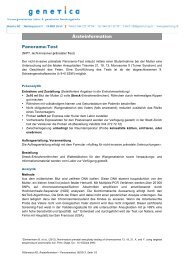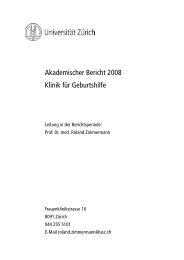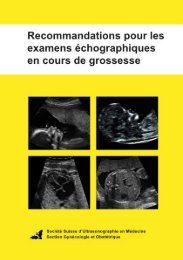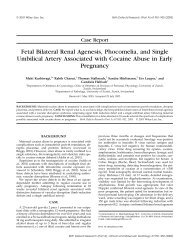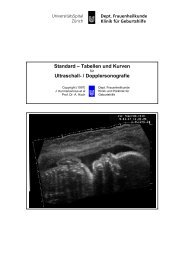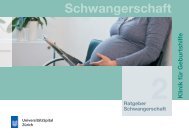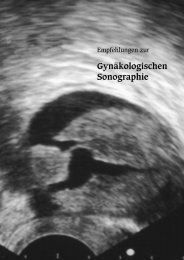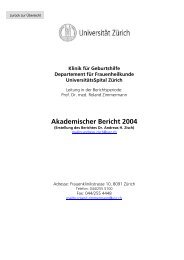Akademischer Bericht 2005 - Geburtshilfe - UniversitätsSpital Zürich
Akademischer Bericht 2005 - Geburtshilfe - UniversitätsSpital Zürich
Akademischer Bericht 2005 - Geburtshilfe - UniversitätsSpital Zürich
Erfolgreiche ePaper selbst erstellen
Machen Sie aus Ihren PDF Publikationen ein blätterbares Flipbook mit unserer einzigartigen Google optimierten e-Paper Software.
Professur/Forschungsbereich: Zisch, Andreas<br />
Biophotonic imaging to study transcriptional regulation of angiogenesis response in tissue in response<br />
to fast or slow release of vascular endothelial growth factor from fibrin implants<br />
Although vascular endothelial cell growth factor (VEGF) has been described as a potent angiogenic<br />
growth factor, its application in therapeutic angiogenesis remains difficult: blood vessels formed by exposure<br />
VEGF tend to be malformed and leaky. In nature, the principal form of this factor possesses<br />
a binding site for extracellular matrix components that may maintain it in the immobilized state until<br />
released by local cellular enzymatic activity.<br />
We have previously reported a mutant form of VEGF, a2PI1-8-VEGF121, that mimics this concept of<br />
matrix binding and cell-mediated release, working in the context of the surgically-relevant matrix fibrin<br />
(CircRes (2004), 94, 1124-32) (slow release formulation). We demonstrated that this engineered VEGF<br />
formulation induces blood vessel formation more potently than conventional formulations of wild-type<br />
VEGF121 in fibrin (fast release formulation), and that those vessels possess more normal morphologies<br />
at the microscopic and ultrastructural levels.<br />
In the present study, we apply non-invasive Xenogen biophotonic imaging method and a subcutaneous<br />
implant model in VEGFR2-luc-mice to examine over weeks the transcriptional regulation of angiogenesis<br />
in tissue exposed to a2PI1-8-VEGF121 (slow release formulation) versus wild-type VEGF121 (fast<br />
release formulation) release from fibrin implants.<br />
01.05.2004-31.12.2006<br />
Professur/Forschungsbereich: Zisch, Andreas<br />
Changes in platelet activity during pregnancy and postpartum<br />
In pregnancy platelets (Tc) can change their activity status (AS). So far the AS has been determined<br />
by complicated methods of surface antibody detection. A new method uses the morphological changes<br />
of activated Tc to determine the AS. The swelling and the degranulation of the Tc is measured by laser<br />
light scatter under 2 angles in flowcytometry. The aim of this study was to determine standard values for<br />
this new method in normal pregnancy and compare it to complicated pregnancies, e.g. preeclampsia.<br />
01.01.2002-31.05.<strong>2005</strong><br />
Professur/Forschungsbereich: Zisch, Andreas<br />
Digital ”mother’s record”<br />
01.01.<strong>2005</strong>-31.12.2006<br />
Professur/Forschungsbereich: Zisch, Andreas<br />
Effects of recombinant human Erythropoietin (rhEPO) on plasma volume, hematocrit and physical performance<br />
The aim of this interdisciplinary investigationis to study the effect of rhEPO on plasma volume, hematocrit<br />
and physical performance in male volunteers. Physical performance will be studied by the Dept.<br />
of Sports Physiology (Prof. U. Boutellier), while the measurements of plasma volume (ICG) and red<br />
cell volume (Na-Fluorescein) will be done in the Dept. of Obstetrics, University Hospital Zurich, with the<br />
support of the Dept. Anesthesiology, University Hospital Munich.<br />
The study were begun in 2002 and interrupted after methodological problems with the measurement of<br />
blood volume. The study were started again winter 2003/2004.<br />
01.02.2002-31.12.<strong>2005</strong><br />
Professur/Forschungsbereich: Zisch, Andreas<br />
Efficacy of intravenous Venofer compared to oral Tardyferon in the prophylaxis of iron deficiency anemia<br />
in pregnant women. An open randomised study<br />
To compare in an open randomised, single centre, phase IV study with 260 pregnant women randomly<br />
assigned to 2 parallel groups, the efficacy of i.v. iron(III)-hydroxide sucrose (Venofer, 200 mg at week 20<br />
and 30) versus oral iron sulphate (Tardyferon, 80 mg/day from week 15.0 until discharge after delivery).<br />
Primary endpoints: the percentage of pregnant women with hemoglobin < 11.0 g/dl.<br />
Klinik für <strong>Geburtshilfe</strong><br />
<strong>Akademischer</strong> <strong>Bericht</strong> <strong>2005</strong><br />
12



